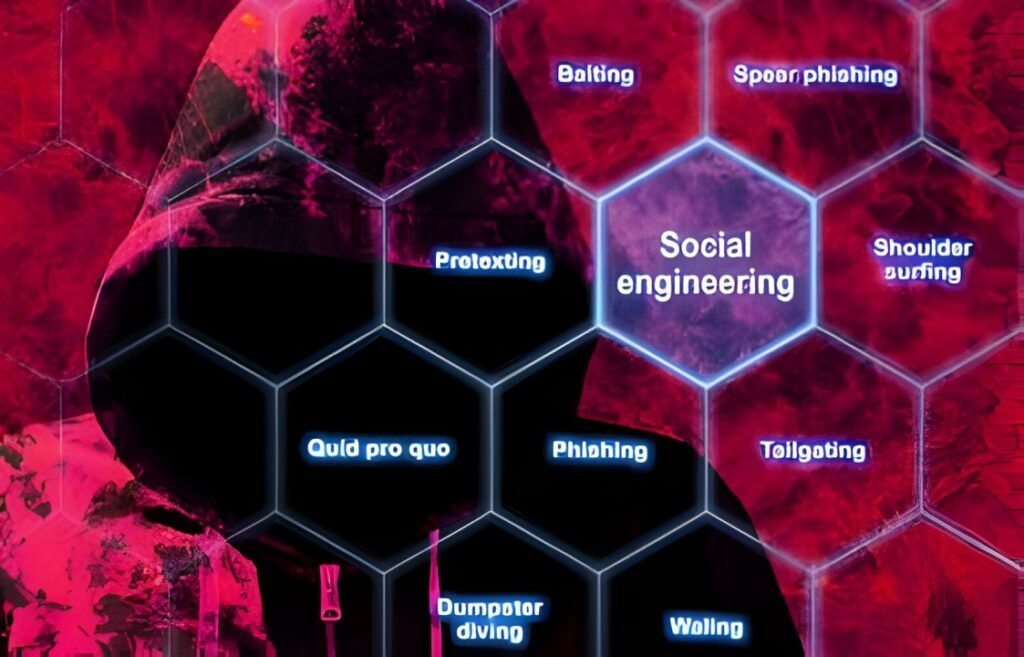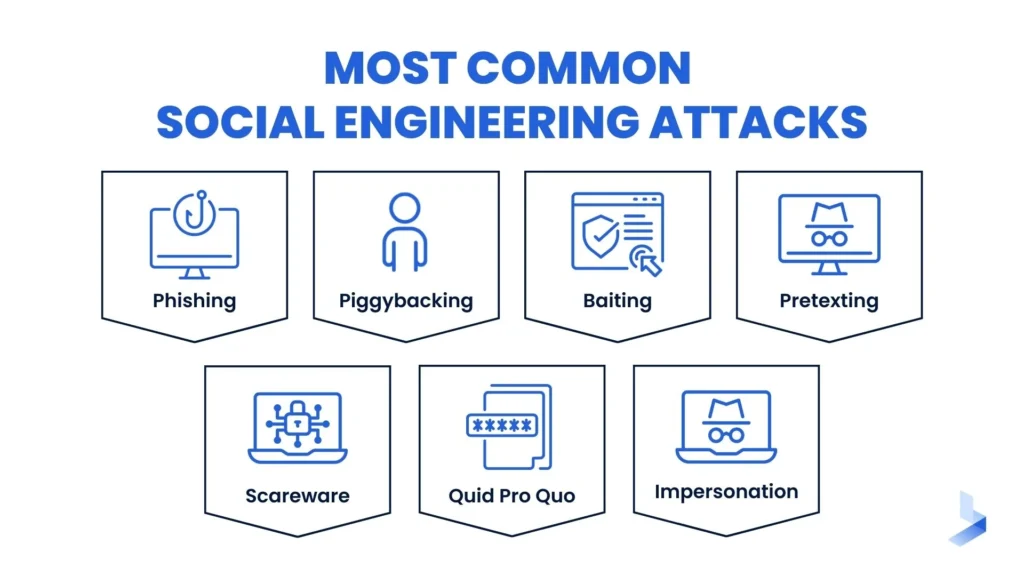Social engineering is the term used for a broad range of malicious activities accomplished through human interactions. It uses psychological manipulation to trick users into making security mistakes or giving away sensitive information.
Social engineering attacks happen in one or more steps. A perpetrator first investigates the intended victim to gather necessary background information, such as potential points of entry and weak security protocols, needed to proceed with the attack.

How does social engineering work?
In a typical social engineering attack, a cybercriminal will communicate with the intended victim by saying they are from a trusted organization. In some cases, they will even impersonate a person the victim knows.
If the manipulation works (the victim believes the attacker is who they say they are), the attacker will encourage the victim to take further action. This could be giving away sensitive information such as passwords, date of birth, or bank account details.
Or they might encourage the victim to visit a website where malware is installed that can cause disruptions to the victim’s computer. In worse case scenarios, the malicious website strips sensitive information from the device or takes over the device entirely.
History of Social Engineering
Social engineering is a practice that is as old as time. As long as there has been coveted information, there have been people seeking to exploit it.
The term social engineering was first used by Dutch industrialist J.C. Van Marken in 1894. Van Marken suggested that specialists were needed to attend to human challenges in addition to technical ones. In 1911, Edward L. Earp wrote Social Engineer as a way to encourage people to handle social relations similarly to how they approach machineries.
Types of social engineering
- Phishing, as we noted above, which also includes text-based smishing and voice-based vishing These attacks are often low-effort but widely spread; for instance, a phisher might send out thousands of identical emails, hoping someone will be gullible enough to click on the attachment.
- Spear phishing, or whaling, is a “high-touch” variation of phishing for high-value targets. Attackers spend time researching their victim, who’s usually a high-status person with a lot of money they can be separated from, in order to craft unique and personalized scam communications.
- Baiting is a key part of all forms of phishing and other scams as well—there’s always something to tempt the victim, whether a text with a promise of a free gift card or something much more lucrative or salacious.
- Pretexting involves creating a story, or pretext, to convince someone to give up valuable information or access to some system or account. A pretexter might manage to find some of your personally identifying information and use it to trick you for instance, if they know what bank you use, they might call you up and claim to be a customer service rep who needs to know your account number to help with a late payment.
- Business email compromise , also known as CEO fraud, combines several of the above techniques. An attacker either gains control of a victim’s email address or manages to send emails that look like they’re from that address, then start sending emails to subordinates at work requesting the transfer of funds to accounts they control.
- In a quid pro quo attack, a hacker offers something in exchange for access or information. A tech support scam is a typical example of a quid pro quo attack.

Traits of Social Engineering Attacks
Social engineering attacks center around the attacker’s use of persuasion and confidence. When exposed to these tactics, you are more likely to take actions you otherwise wouldn’t.
Among most attacks, you’ll find yourself being misled into the following behaviors:
Heightened emotions : Emotional manipulation gives attackers the upper hand in an any interaction. You are far more likely to take irrational or risky actions when in an enhanced emotional state. The following emotions are all used in equal measure to convince you.
- Fear
- Excitement
- Curiosity
- Anger
- Guilt
- Sadness
Urgency: Time-sensitive opportunities or requests are another reliable tool in an attacker’s arsenal. You may be motivated to compromise yourself under the guise of a serious problem that needs immediate attention. Alternatively, you may be exposed to a prize or reward that may disappear if you do not act quickly. Either approach overrides your critical thinking ability.
Trust: Believability is invaluable and essential to a social engineering attack. Since the attacker is ultimately lying to you, confidence plays an important role here. They’ve done enough research on you to craft a narrative that’s easy to believe and unlikely to rouse suspicion.
How do I protect myself and my organization against social engineering?
Consistent training tailored for your organization is highly recommended. This should include demonstrations of the ways in which attackers might attempt to socially engineer your employees. For example, simulate a scenario where an attacker poses as a bank employee who asks the target to verify their account information.
Organizations should also establish a clear set of security policies to help employees make the best decisions when it comes to social engineering attempts. Examples of useful procedures to include are:
Password management: Guidelines such as the number and type of characters that each password must include, how often a password must be changed, and even a simple rule that employees should not disclose passwords to anyone regardless of their position–will help secure information assets.
Multi-factor authentication: Authentication for high-risk network services such as modem pools and VPNs should use multi-factor authentication rather than fixed passwords.
Email security with anti-phishing defenses: Multiple layers of email defenses can minimize the threat of phishing and other social-engineering attacks. Some email security tools have anti-phishing measures built in.
Social engineering attack techniques
Social engineering attacks come in many different forms and can be performed anywhere where human interaction is involved. The following are the five most common forms of digital social engineering assaults.
Baiting
As its name implies, baiting attacks use a false promise to pique a victim’s greed or curiosity. They lure users into a trap that steals their personal information or inflicts their systems with malware.
Victims pick up the bait out of curiosity and insert it into a work or home computer, resulting in automatic malware installation on the system.
Scareware
Scareware involves victims being bombarded with false alarms and fictitious threats. Users are deceived to think their system is infected with malware, prompting them to install software that has no real benefit (other than for the perpetrator) or is malware itself.
Pretexting
Here an attacker obtains information through a series of cleverly crafted lies. The scam is often initiated by a perpetrator pretending to need sensitive information from a victim so as to perform a critical task.
Phishing
As one of the most popular social engineering attack types, phishing scams are email and text message campaigns aimed at creating a sense of urgency, curiosity or fear in victims. It then prods them into revealing sensitive information, clicking on links to malicious websites, or opening attachments that contain malware.
Spear phishing
This is a more targeted version of the phishing scam whereby an attacker chooses specific individuals or enterprises. They then tailor their messages based on characteristics, job positions, and contacts belonging to their victims to make their attack less conspicuous.

Advantages of Social Engineering
Social engineering is a manipulative technique used to exploit human psychology rather than technical vulnerabilities. Here are some advantages from an attacker’s perspective
Bypassing Technical Defenses
- Direct Access: Social engineering can grant direct access to systems, networks, or sensitive information.
- Evading Detection: Unlike traditional hacking methods, it often leaves little to no digital footprint.
Cost-Effective and Efficient
- Low Resource Requirements: It typically requires minimal technical expertise or expensive tools.
- High Success Rate: Human error is prevalent, making it highly effective.
Exploiting Human Nature
- Trust and Empathy: People are generally trusting and empathetic, making them susceptible to manipulation.
- Urgency and Fear: Creating a sense of urgency or fear can pressure victims into making hasty decisions.
Gathering Intelligence
- Information Gathering: Social engineers can collect valuable information about targets for future attacks.
- Building Trust: Establishing relationships can provide long-term access to sensitive information.
Adaptability
- Flexible Approach: Social engineering can be tailored to specific targets and situations.
- Continuous Evolution: Attackers can adapt their techniques based on changing human behavior.
Disadvantages of Social Engineering
While social engineering can be a powerful tool for attackers, it also carries several drawbacks:
Ethical and Legal Implications
- Moral Concerns: Social engineering often involves deception and manipulation, which raises ethical questions.
- Legal Consequences: Successful attacks can lead to severe legal penalties, including imprisonment.
Human Element and Unpredictability
- Reliance on Human Error: Success depends on the target’s susceptibility, which can vary greatly.
- Countermeasures: Increased awareness and training can reduce the effectiveness of social engineering attacks.
Reputation and Trust Damage
- Negative Publicity: Successful attacks can damage an attacker’s reputation and make future attempts more difficult.
- Loss of Trust: Targets who fall victim to social engineering may become more cautious, hindering future attacks.
Resource Intensive
- Time-Consuming: Building trust and relationships can be time-consuming and requires patience.
- Skill Requirement: Effective social engineering often demands strong interpersonal and communication skills.
Detection and Prevention
- Advanced Defenses: Organizations are implementing security measures to detect and prevent social engineering attacks.
- Behavioral Analysis: Sophisticated tools can analyze user behavior to identify suspicious activity.
Social engineering prevention
Social engineers manipulate human feelings, such as curiosity or fear, to carry out schemes and draw victims into their traps. Therefore, be wary whenever you feel alarmed by an email, attracted to an offer displayed on a website, or when you come across stray digital media lying about.
- Don’t open emails and attachments from suspicious sources – If you don’t know the sender in question, you don’t need to answer an email. Even if you do know them and are suspicious about their message, cross-check and confirm the news from other sources, such as via telephone or directly from a service provider’s site.
- Use multifactor authentication – One of the most valuable pieces of information attackers seek are user credentials. Using multifactor authentication helps ensure your account’s protection in the event of system compromise. Imperva Login Protect is an easy-to-deploy 2FA solution that can increase account security for your applications.
- Be wary of tempting offers – If an offer sounds too enticing, think twice before accepting it as fact. Googling the topic can help you quickly determine whether you’re dealing with a legitimate offer or a trap.
- Keep your antivirus/antimalware software updated – Make sure automatic updates are engaged, or make it a habit to download the latest signatures first thing each day. Periodically check to make sure that the updates have been applied, and scan your system for possible infections.
Unusual Social Engineering Methods
In some cases, cybercriminals have used complex methods to complete their cyberattacks, including:
- Fax-based phishing: When one bank’s customers received a fake email that claimed to be from the bank — asking the customer to confirm their access codes – the method of confirmation was not via the usual email / Internet routes. Instead, the customer was asked to print out the form in the email, then fill in their details and fax the form to the cybercriminal’s telephone number.
- Traditional mail malware distribution: In Japan, cybercriminals used a home-delivery service to distribute CDs that were infected with Trojan spyware. The disks were delivered to the clients of a Japanese bank. The clients’ addresses had previously been stolen from the bank’s database.
How to respond to a social engineering attack
If you suspect your organization has been the target of a social engineering attack, it should take the following steps to respond and mitigate the risk of further attacks:
- dentify the source of the attack and gather as much information as possible about the attack, including the type of attack, how it was delivered, and what information or access may have been compromised.
- Notify all relevant stakeholders, including management, IT staff, and employees, about the attack and instruct them on how to protect themselves and their systems.
- Change any compromised passwords and implement additional security measures, such as two-factor authentication, to prevent further attacks.
- Review and update security policies and procedures to address any weaknesses that may have contributed to the attack.
- Monitor systems and networks for any signs of further attacks or malicious activity.
- Consider engaging a cybersecurity professional to conduct a comprehensive review of the organization’s security posture and to provide recommendations for improving security.
How to spot social engineering attacks
The security company Norton has done a pretty good job of outlining some red flags that could be a sign of a social engineering attack.
- Someone you know sends an unusual message: Stealing or mimicking someone’s online identity and then mining their social circles is relatively easy for a determined attacker, so if you get a message from a friend, relative, or coworker that seems off, be very sure you’re really talking to them before you act on it.
- A stranger is making an offer that’s too good to be true: Again, we all laugh at the Nigerian prince emails, but many of us still fall for scams that trick us by telling us we’re about to get something we never expected and never asked for.
Challenges of Social Engineering
Human Factor Challenges
- Unpredictability: Human behavior is complex and can be difficult to manipulate consistently.
- Suspicion: Increased awareness of social engineering attacks can make people more cautious.
- Building Trust: Establishing trust takes time and effort, and can be easily broken.
Technological Advancements
- Security Measures: Organizations are implementing security awareness training and tools to combat social engineering.
- Behavior Analytics: Advanced technologies can detect unusual patterns in user behavior.
- Multi-Factor Authentication: This security measure adds an extra layer of protection against unauthorized access.
Legal and Ethical Implications
- Legal Consequences: Successful social engineering attacks can lead to severe legal penalties.
- Ethical Dilemmas: Many people find the manipulative nature of social engineering morally reprehensible.
- Reputation Damage: Being associated with social engineering can harm an attacker’s reputation.
Evolving Threat Landscape
- Staying Updated: Attackers must constantly adapt to new security measures and human behaviors.
- Competition: The increasing number of cybercriminals can lead to increased competition for targets.
How to Prevent and Protect Against Social Engineering
The best form of prevention against social engineering attacks is end-user training. Teaching your employees how to recognize social engineering tactics and avoid them is of the utmost importance.
- Research any suspicious calls, emails or texts.
- Open attachments only from trusted sources.
- Immediately delete any emails or texts asking for passwords or personally identifiable information (PII), such as social security numbers or financial information.
- Don’t open any emails promising prizes or notification of winnings.
- Download software only from approved sources.
- Be wary of urgent requests or solicitations for help.
- Make sure you have spam filters and antivirus software on your device.
- When in doubt, contact IT to confirm any technology-related requests.
Examples of Social Engineering Attacks
When malware creators use social engineering techniques, they can lure an unwary user into launching an infected file or opening a link to an infected website. Many email worms and other types of malware use these methods.
Worm Attacks
The cybercriminal will aim to attract the user’s attention to the link or infected file – and then get the user to click on it.
- The LoveLetter worm that overloaded many companies’ email servers in 2000. Victims received an email that invited them to open the attached love letter.
- The Mydoom email worm — which appeared on the Internet in January 2004 — used texts that imitated technical messages issued by the mail server.
- The Swen worm passed itself off as a message that had been sent from Microsoft. It claimed that the attachment was a patch that would remove Windows vulnerabilities. It’s hardly surprising that many people took the claim seriously and tried to install the bogus security patch — even though it was really a worm.
Peer-to-Peer (P2P) Network Attacks
P2P networks are also used to distribute malware.
- AIM & AOL Password Hacker.exe
- Microsoft CD Key Generator.exe
- PornStar3D.exe
- Play Station emulator crack.exe

Conclusion
Social engineering remains a significant threat to individuals and organizations. Its effectiveness lies in exploiting human psychology rather than technological vulnerabilities. While it offers potential advantages to attackers, it also carries substantial risks, including legal and ethical consequences.
The dynamic nature of human behavior and the constant evolution of technology create a complex landscape for both attackers and defenders. While attackers adapt their techniques to stay ahead, organizations and individuals must prioritize security awareness and implement robust countermeasures.
Ultimately, the human factor is the weakest link in cybersecurity. By understanding the tactics used by social engineers and fostering a culture of skepticism, individuals and organizations can significantly reduce their vulnerability to these attacks.
FAQs
Social engineering attacks manipulate people into sharing information that they shouldn’t share, downloading software that they shouldn’t download, visiting websites they shouldn’t visit, sending money to criminals or making other mistakes that compromise their personal or organizational security.
However, social engineering is a threat where an attacker tricks a targeted user into divulging sensitive information by pretending to be a familiar person or service.